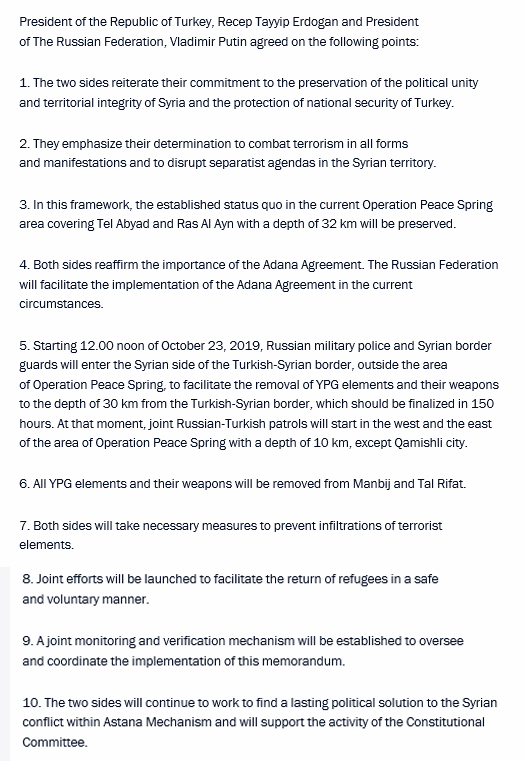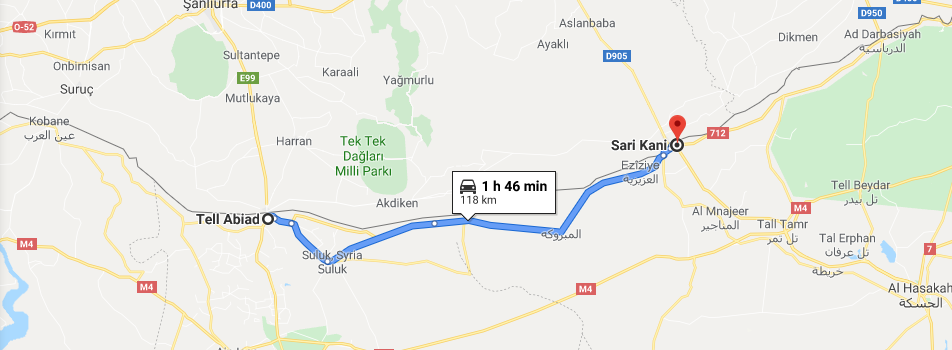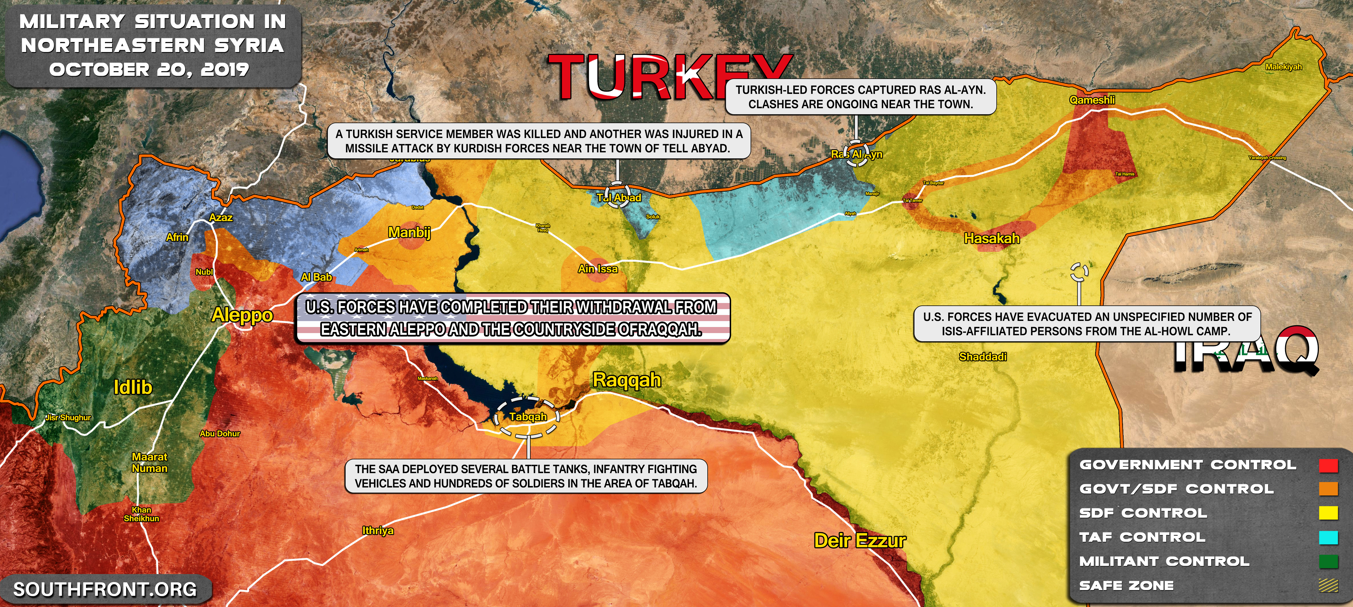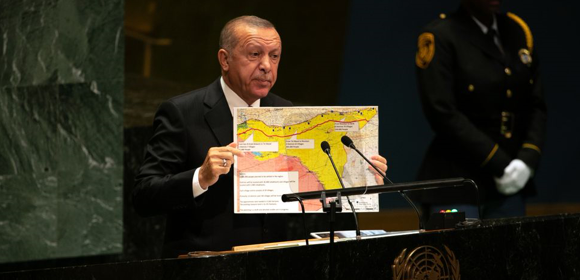THE SULTAN BLINKED, THE TSAR AGREED TO CLOSE HIS EYES – THE OTTOMAN EMPIRE EXPANDS BY 118 KILOMETRES OF SYRIA
by John Helmer - Dances with Bears
October 23, 2019
After one of the longest, bitterest negotiations ever held between President Vladimir Putin and President Recep Tayyip Erdogan, Russia’s Defence Minister Sergei Shoigu and Foreign Minister Sergei Lavrov forced the Turks into an agreement for a Turkish military enclave inside Syrian territory between Tal Abiad and Ras Al-Ain (Sari Kani). That is less than one-quarter of the Syrian territory Erdogan was demanding at the start of the Sochi talks.
The Turkish advance eastwards along the Syrian Highway M4 to the Iraqi border has been stopped. The Syrian Army will reoccupy the eastern zone to the Yarubiya crossing, with Russian military police on the ground; that also means the Russian Air Force in the air.
The practical result is that Russia accepts that the Turkish capture of Tal Abiad and Ras-Al-Ain since October 9 will not be reversed. This territory will thus be added to the Turkish hold on Afrin and Idlib in Syria’s northwest.
Shoigu told reporters there was no discussion of how long the Turkish forces will occupy these areas. This is a major Russian concession to the Turkish demand for permanent military occupation and partition of Syria.
The Russians believe this concession is worth making to the Turks so long as the Americans are forced out; this is the message Putin has relayed to the Syrian President Bashar al-Assad.
According to a statement by Lavrov, the paper which Erdogan agreed last Thursday (October 17) in Ankara with US Vice President Mike Pence and Secretary of State Mike Pompeo has been dismissed. “We do not particularly look at the United States and its stance. That stance is quite variable and contradictory, and of course, the coalition led by the United States is in Syria illegally, this is well known,” Lavrov said after the talks ended in Sochi.
Putin hinted at the same point, announcing during his press conference with Erdogan: “Syria must be liberated from illegal foreign military presence. We believe that the only way to achieve strong and long-lasting stability in Syria is to respect the sovereignty and territorial integrity of the country. This is our principled position, and we have discussed it with the President of Turkey. It is important that our Turkish partners share this approach. The Turks and the Syrians will have to protect peace on the border together, which would be impossible without mutually respectful cooperation between the two countries.
The Kremlin has published the 10-point agreement titled “Memorandum of Understanding between Turkey and the Russian Federation”:
Lavrov read out the text in his press conference with Turkish Foreign Minister Mevlüt Çavuşoğlu.
The Sochi talks commenced yesterday afternoon before 1400 in what was officially described as a “restricted format”. The Kremlin record shows the Russian delegation sitting to the left of Putin.
Source: http://en.kremlin.ru/
Russian media reporting has named the members of the Turkish delegation, but not the Russian one.
The Russian row, seated in the same protocol order as the Turkish delegation (in the foreground of the larger Kremlin picture) starts with Lavrov and Shoigu. To their left are the presidential foreign affairs advisor Yury Ushakov and on the far left, Alexander Lavrentiev, the Foreign Ministry’s special negotiator on Syria. Between Ushakov and Lavrentiev is a Russian official who has not been identified officially. He is sitting opposite Hakan Fidan, the head of the Turkish intelligence organization MIT. The Russian is believed to be the deputy head of the Russian Foreign Intelligence Service (SVR), Victor Lavrentsov. The Kremlin Press Office was asked to identify the official; it refused.
Significantly, the Russian lineup omits Dmitry Peskov, the strongest advocate for Turkish interests in the Kremlin.
The press conference which followed with Lavrov and his Turkish counterpart Cavusoglu began more than seven hours after the talks had opened, with the first Foreign Ministry posting at 21:51.
The terms now published elevate the Turkish definition of their “national security” to parity with the Russian position on the “preservation of the political unity and territorial integrity” of Syria. By subjecting this to the Adana Protocol of 1998, the Russians have implied, but not insisted, that the Turks limit their invasion of Syria to “hot pursuit” of terrorists, as already agreed by Damascus. That is the meaning of Point 4.
But Point 3 is a flat contradiction. By fixing the demarcation of the new Turkish military zone, 118 kilometres west to east, and 32 kms deep, Putin has given Erdogan what he has already taken, and added a Russian guarantee on the ground.
The road map shows the new Turkish zone, north of the M4 highway by about 20 kms. The implication of the Russian-Turkish memorandum is that Putin has conceded Turkish military control of the Tel Abiad and Ras al-Ain (Sari Kani) section of the strategic autoroute. The operations map shows the Turkish occupation of Syria in blue.
Click on image to enlarge
Source: https://southfront.org/
The reference to Qamishli in Point 5 confirms Turkish agreement to the reoccupation of the city and the region around it to the Iraqi and Turkish frontiers by the Syrian Army and government administration. The reference in Point 6 to Tal Rifat, which is north of Aleppo and east of Afrin, is ambiguous. It implies that the Turkish Army will move its Afrin line of occupation eastwards by about 10 kms in exchange for the Syrian government takeover of Manbij.
Taken together, the terms amount to a joint ultimatum to the Kurds – either make peace with Damascus, or fight alone against the Turks, and also against the Russian military patrols scheduled to appear at noon today (October 23), according to Point 5.
The detail of the operational, ethnic and political maps which have been invoked in the new deal reveals the extent to which Putin was prompted by his principal advisors to avoid the mistakes of his Idlib agreement of last September. For what they were, read this. On the other hand, Putin has demonstrated, again, that the Turks can force his hand with faits accomplis on the battlefield. The Stavka – the combination of the Russian battlefield and General Staff commands, plus Foreign Ministry experts like Lavrentiev – have tried to mitigate the losses Putin is willing to concede.
Putin and the pro-Turkish circle around him – they appear to include Peskov and Ushakov — have avoided a meeting of officials for debate of their policy options. At the highest level in the Kremlin, that should have occurred in the Security Council; neither Peskov nor Ushakov are members. But the last time Putin met with the Council was on October 8, the day before the Turkish invasion started. Syria was the principal topic, according to the communiqué. The officials “discussed the deterioration of the situation in the northeastern of Syria. [They] also exchanged views on the start of work of the Syrian Constitutional Committee. They noted that at this stage it is important to avoid any actions that could create obstacles to a peaceful settlement in Syria.” Very unusually, however, both Shoigu and Lavrov were absent from that meeting. Also missing was a representative of the Foreign Intelligence Service (SVR).
The Security Council meeting in the Kremlin, October 8 (left to right): Nikolai Patrushev, Council Secretary; Vyacheslav Volodin, State Duma Speaker; Prime Minister Dmitry Medvedev; President Putin. Source: http://en.kremlin.ru/
In the new Sochi agreement how much the Turks have gained, how much they have conceded, can be gauged from the record of their demands to start with. These were issued publicly by Ibrahim Kalin, speaking to TRT, the Pakistan state television agency, last Saturday (October 19). The US-educated Kalin is both Erdogan’s spokesman and his foreign policy adviser. He was one of the officials Lavrentiev met in Ankara in the hours preceding the arrival of Pence, Pompeo and the US delegation; according to Kalin, he was Lavrentiev’s host. That was last Thursday, October 17.
The next day, Friday October 18, Lavrentiev was in Damascus to meet Assad. The record of what they agreed was an understanding, in Assad’s words, that the Russians would press for “the pullout of all illegal forces, including the Turkish and American soldiers, from Syrian territory.”
Lavrentiev himself had said earlier – in Abu Dhabi on October 15 – that “the security of the Turkish-Syrian border must be ensured by the deployment of Syrian government troops along its entire length. That’s why we never spoke in favour or supported the idea of Turkish units (being deployed there) let alone the armed Syrian opposition.” The “entire length” meant exactly that. For analysis of the details, read this.
Kalin told Lavrientiev otherwise.
Left, Alexander Lavrentiev; right, Ibrahim Kalin in interview with Pakistan state television on October 19. Source: https://www.youtube.com/ In the Sochi meeting between Putin and Erdogan, Kalin was seated in the Turkish delegation opposite Ushakov in the Russian delegation.
Since then, in his Pakistani broadcast Kalin has acknowledged the Turks have a “Phase B” plan to follow their military occupation. Watch him elaborate the details for “talking to the Russians” from Minute 22 of the video clip.
Referring to the areas of northern Syria evacuated by the US forces supporting the Kurds, Kalin said:
“we want to make sure that [on] the map our President showed to the UN General Assembly [there will be] one unified area for the refugees as a safe zone. We want to do it, part of it with the Americans [Tel Abiad]… The rest, of course, we will have to talk with the Russians to make sure that this remains a safe zone for the refugees to go back to.”
Kalin was also categorical – the Turkish resettlement of northern Syria will be for refugees who do not accept the Damascus government. He was emphatic that Turkish policy is to continue the war to remove Assad. “If the YPG replaces the American flag with the Russian flag, it’s no good for us either… I believe we have a common understanding [with the Russians] as to how we can manage this area. It is in the common interest of all the actors involved to keep this area clear from YPG [Kurds], the regime [the Assad government] and others [pro-Assad tribes], so that the refugees can feel safe and go back voluntarily.”
Watch as Kalin uses his hands to describe the geographical extent of the Turkish plan of occupation and partition of northern Syria, extending from Afrin in the west to the Iraqi border in the east.
Left, Kalin speaks of the Afrin-Tel Abiad zone, Min 24:35. Right: Kalin speaks of the “rest”, Min 24:52. Source: https://www.youtube.com/Erdogan’s map, to which Kalin referred, was presented at the UN General Assembly on September 24. The full extent of the Turkish occupation zone is plain to see.
Source: https://www.bloomberg.com/
Erdogan has repeated his demand for the full 440-km zone of occupation since the invasion started. He said as much to US officials, including President Donald Trump. “The ‘safe zone’ will stretch 440km along Turkey’s border from the Euphrates river to the Iraqi border, Mr Erdogan told reporters. Mr Pence said late on Thursday it would run 30km deep, but did not specify the total expanse. Some areas that Turkey wants to hold in the safe zone are now under Syrian, Russia and Kurdish control.”
Point 8 of the Sochi agreement says “joint efforts will be launched to facilitate the return of refugees in a safe and voluntary manner.” This echoes exactly what Kalin said in his Pakistan television interview. But the geographic areas illustrated by Kalin’s hands and on Erdogan’s map have been curtailed significantly.
Russian military analysts and Middle Eastern specialists in Moscow are fearful of commenting, even off the record, particularly since Lavrov and Shoigu remain reticent. Many believe that Putin has failed to secure Erdogan’s agreement to end his war for regime change in Damascus. He has also failed, the sources think, to enforce the repatriation of Turkish troops from the Syrian territory they occupy.
Worse, Putin’s paper does not prevent the Turks from sharing their occupation with the Pentagon; according to Point 10 of the Pence-Pompeo paper, “the safe zone will be primarily enforced by the Turkish Armed Forces and the two sides will increase their cooperation in all dimensions of its implementation.” Ahead of yesterday’s meeting, speaking for Putin, Ushakov claimed: “we are generally positive about the results of the talks between the Turkish leadership and the US Vice President.”










No comments:
Post a Comment